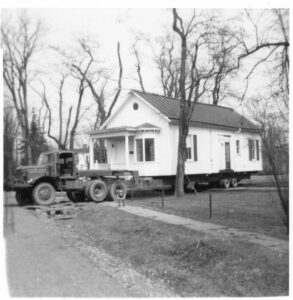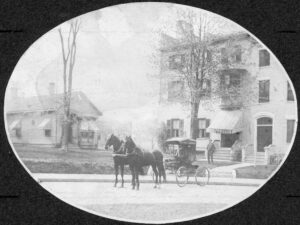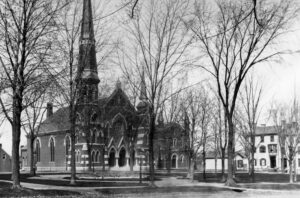The Missing House on Park Place
By Becky Chapin, Archivist
Charles Williamson certainly meant for Park Place to be the heart of Geneva. As he laid out his plans, Pulteney Park was supposed to be the central business district for the village. Most of the houses on Park Place were filled by businesses like a bank, printer, tailor, doctor’s offices, and more. But with the water transportation becoming more popular, more businesses began forming around what is now downtown Geneva.

The Achilles House moving out of Park Place.
According to long time Geneva resident, Robert S Breed, the lot was originally the location of the temporary land office in 1792 and then deeded to the Presbyterian Church in 1807. A two-story brick house was built by the Rodney family on that lot in 1827, shortly after the Masonic Hall was completed between the church and the Rodneys. Cornelius Rodney was a tailor who operated his shop out of the building, though it’s unclear after 1834 what happened as his advertisements disappeared from the newspaper. The Masonic Hall lot was purchased by the First Presbyterian Church in 1864 and a parish hall was built in its place.There were still schools and other businesses that operated on Park Place; one such building was 12 Park Place. If you look at a map today, there is no 12 Park Place. That’s because the house was moved by the Geneva Historical Society in 1966 and became the guard house at Lochland School.
Dr. John Pope Delaney (b. 1857) would open his doctor’s office at 12 Park Place in 1885 after receiving his degrees from Hobart College. His siblings and their families were residing with him at 10 Park Place until their deaths. Dr. Delaney retired in 1929 and died in 1932 from being struck by a car as he crossed South Main St. Dr.

12 and 10 Park Place, Dr. Delaney standing in front of his home at 10 Park Place c. 1901.
Dr. Delaney left his home to his neighbor and friend, Mrs. Orpha Butts and it passed through several hands (including Thomas Kenny, Annie Herendeen, DW Crance, and Josephine Nester) between 1932 and 1952-3 when it then became the residence of Dr. William Achilles. At this point, the house would become known as the Achilles house.
The First Presbyterian Church would become its owner after Dr. Achilles and it remained vacant for a few years in the 1960s before the church started using it as their nursery. In 1965, the First Presbyterian Church started to make plans to remodel and expand the parish house into a Christian education wing, which meant they planned to demolish the Achilles House. But amid outcries to save the building, the Geneva Historical Society stepped in and moved the house from Park Place to Lochland School through the Historic Fund for Geneva.

The First Presbyterian Church, the parish house, and Dr. Delaney’s office to the right, in Park Place
The Fund was established in 1965 by Warren Hunting Smith who proposed, “setting up some sort of revolving fund to be administered by the Historical Society to aid in the restoration or preservation of some of the more valuable buildings in town.” Through this agreement, the Historical Society has been able to fund repairs, restoration work, and also moving Ludlow House from Pulteney St to Main St when the Geneva High School wanted to build a new south wing and parking lot.
I thought the story of the Achilles house was a well-known one, but when I used it as an entry for my “Two Truths and a Lie” program in April, many participants didn’t know it. And it isn’t the first time Genevans tried to move buildings to save them. In 1839, the First Presbyterian Church congregation sold their first church to the Baptists after raising funds to build a new church. The building was mounted on rollers to start its journey across the street, but then oddly burned to the ground on its way there. Luckily, the Achilles and Ludlow houses survived their moves and are still in use today.
